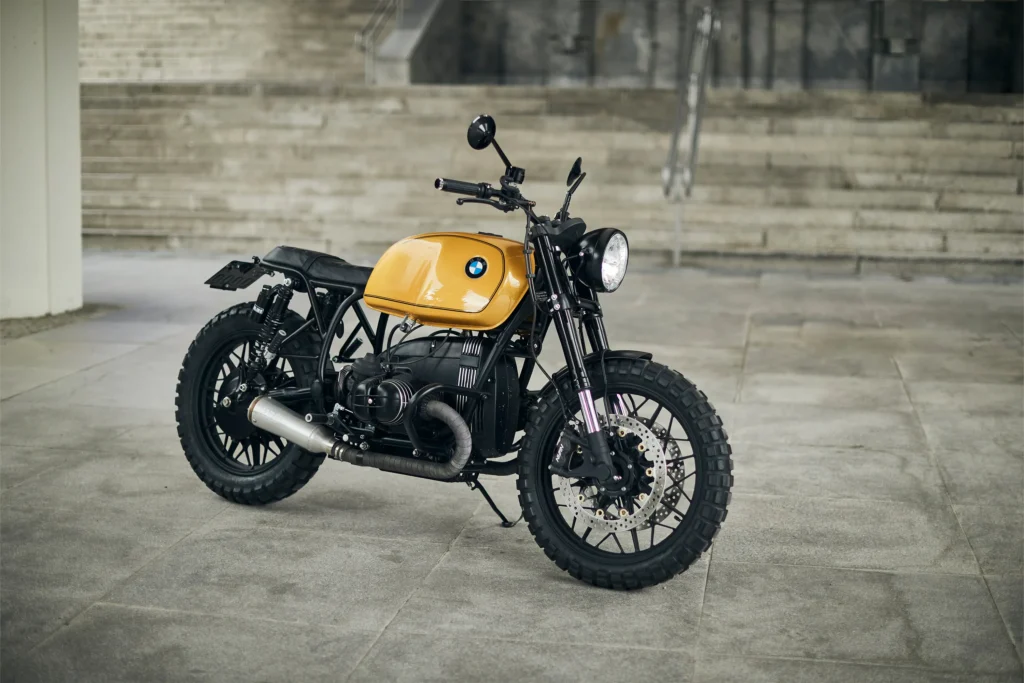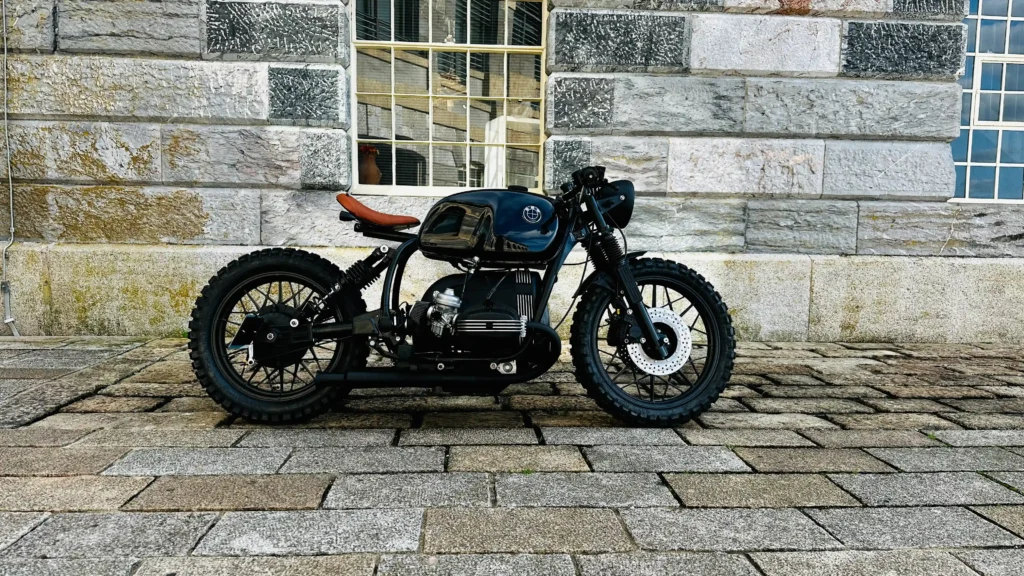Table of Contents
ToggleWhen you start building a café racer from a Honda CB350, you’re stepping into a world of endless choices. It’s not just about making the bike look great (though that’s definitely part of the appeal); it’s also about boosting power, sharpening handling, and creating that classic café racer style. As you think about what mods are necessary for a Honda CB350 Café Racer build, whether you’re restoring an old CB350 from scratch or tuning up one that’s in good shape, there are a few key upgrades you’ll need to focus on to make this bike a true café racer.

So, what needs to be done? In this guide, I’ll show you the steps to make a Honda CB350 café racer better. We’ll talk about how to make it faster and look cooler. We’ll go through each step so you can make your bike ride well and look amazing.
Essential Modifications for a Honda CB350 Café Racer
Building a café racer is all about taking the bike down to its essentials and boosting performance where it matters. You want a bike that’s light, fast, and handles well. To get this, there are a few areas you need to focus on.
Performance Enhancements
- Performance is a key part of any café racer build. Café racers aren’t just about looking fast; they’re built for speed and agility. Here’s how you can give your Honda CB350 the extra power it needs:
- Engine Upgrades: The engine is the heart of your bike, and upgrading it is key to improving performance. Most riders choose oversized pistons and a custom ground camshaft to increase power. A popular choice for the CB350 is Wiseco pistons, which provide higher compression and better overall performance. If you want more horsepower, upgrading to Mikuni 30mm carburetors is a great option.
- Exhaust System: A café racer should sound as good as it looks, and that’s where the exhaust system plays a big role. A 2-into-1 exhaust system is a popular modification, not only because it reduces weight but also improves airflow and gives the bike that deep, throaty sound café racers are famous for. It’s also an excellent way to boost the overall performance and style of your CB350.
- Carburetors: The stock carburetors on the CB350 can be limiting, especially if you’re upgrading other engine parts. Swapping them for Mikuni VM30 or VM32 carbs is a smart choice. These carburetors allow better fuel flow, leading to improved throttle response and overall performance.
- Ignition System: While upgrading the engine, don’t overlook the ignition system. Many riders choose to upgrade to an electronic ignition system for better reliability and easier starts. This modern upgrade can make your engine run smoother and more efficiently, which is perfect for a performance-focused build.
Suspension & Handling Upgrades
A café racer isn’t just about speed—it’s also about how well it handles on the road. The Honda CB350, in its stock form, wasn’t designed for the aggressive riding positions or high-performance handling that café racers are known for. So, if you want your bike to handle better, especially when taking corners at speed, you’ll need to upgrade the suspension and improve overall handling.
Here’s how you can do that:
1. Front Suspension:
The stock front forks on the Honda CB350 are decent, but they aren’t built to handle today’s riding conditions. A common upgrade is to install cartridge emulators, which mimic the performance of modern forks. These are fairly easy to fit and can make a big improvement in handling, especially on rough roads. If you want to take it further, you can swap the entire front end for a USD (upside-down) fork setup. This is a pricier, high-performance option that greatly improves front-end stability and cornering.
2. Rear Shocks:
Upgrading the rear shocks is just as important as improving the front suspension. The CB350’s stock shocks are outdated, so replacing them with modern, adjustable shocks will give you better ride quality and comfort. Brands like Ohlins or Hagon are well-known for producing high-quality shocks that can be tuned to your weight and riding style. Adjustable shocks let you fine-tune the damping and rebound, ensuring your bike performs well in all types of riding conditions.
3. Lightweight Wheels:
One of the easiest ways to improve your bike’s handling is by reducing its weight, and swapping the stock wheels for lighter options is a great way to do this. Aluminum rims are a popular choice because they lower the unsprung weight (the weight not supported by the suspension), helping the bike handle better at higher speeds. These rims not only boost handling but also give the bike a sleeker appearance.
4. Steering & Fork Brace:
Café racers are built for speed, and the steering geometry is key to how well the bike handles. Many builders add a fork brace to stiffen the front end and improve steering response. This is especially important if you’ve removed the front fender, which usually adds some stability. The fork brace helps prevent front-end flex and makes the bike feel more solid when cornering.
Aesthetic Modifications
Once you’ve handled the performance and handling of your Honda CB350, it’s time to focus on the visual elements—the things that give it that true café racer style. The café racer look is all about a stripped-down, minimalist design that highlights speed and agility. Here’s how you can transform your CB350 into a sleek, classic café racer with a few key aesthetic modifications.
1. Café Racer Seat & Tail Section
The seat is one of the most iconic parts of any café racer. Café racers usually have a humped or flat, narrow seat that gives the bike a more aggressive, race-ready look. For the Honda CB350, you’ll likely need to cut and modify the rear frame to fit a custom café racer seat. Many builders choose a fiberglass or aluminum tail section, which can be bought pre-made or custom-made to fit your bike.
You’ll also want to clean up the battery and wiring, making everything under the seat look tidy and minimal. Some builders even create a hidden electronics box to store everything neatly.
2. Fuel Tank Modifications
The fuel tank is a key part of a café racer. Café racers often have long, sleek tanks that help the rider get into a more aerodynamic position. You can keep the stock CB350 tank if you like, but many builders choose a racing-style tank with knee indents. This not only looks great but also makes riding more comfortable.
There are many aftermarket tanks to choose from, or you can modify the original tank by adding knee indents. You can also repaint it to match your café racer’s color scheme.
3. Clip-On Handlebars
Clip-on handlebars are essential for any café racer. They give the bike a classic low-profile look and help the rider lean forward, improving aerodynamics. Clip-ons attach directly to the forks and replace the bulky, upright stock handlebars.
While clip-ons look great, they also change the bike’s ergonomics, making long rides less comfortable. If you plan to ride your CB350 café racer for long distances, you might want to consider clubman handlebars instead. These bars look similar to clip-ons but are mounted higher, giving a more comfortable riding position.
4. Rearset Footpegs
To match the aggressive stance of the clip-on handlebars, you’ll need to add rearset footpegs. Rearsets move the foot controls to the back of the bike, letting you lean in more and take corners with better agility.
Installing rearsets can be tricky because it often needs custom brackets or new mounts, but it’s worth the effort. The result is a better riding position and the classic café racer look.
5. Lighting and Indicators
Upgrading the lighting on your Honda CB350 is about both style and safety. Many riders replace the stock lighting with LED headlights, taillights, and turn signals. LEDs are brighter and more reliable than stock incandescent bulbs, making you more visible on the road.
For a true café racer look, think about a round LED headlight with a vintage-style housing. You can also choose minimalist bar-end turn signals and a small, sleek tail light mounted under the seat.
6. Custom Paint and Finishes
The paint job is your chance to get creative. Café racers usually have clean, simple paint schemes, often with just one or two colors and subtle accents. Popular color combos include matte black with silver, British racing green, or gloss white with red stripes. You can also add custom decals or pinstriping to make the bike stand out.
Besides paint, think about finishing touches like powder coating the frame or adding chrome accents to the exhaust and engine parts. These small details can take your bike from a basic build to a fully custom café racer.
Electrical & Lighting Modifications
Upgrading the electrical system of a Honda CB350 café racer is key, especially if you want to modernize your bike and make it more functional. Electrical upgrades usually focus on boosting reliability, increasing visibility, and simplifying the overall design. Here’s how you can improve your CB350’s electrical system and lighting to match the café racer style while enhancing performance and safety.
1. LED Lighting: Headlights, Taillights, and Turn Signals
One of the easiest and best electrical upgrades is replacing the old stock lighting with modern LED lights. LED lights are brighter, more energy-efficient, and last longer than traditional bulbs. They improve safety by making you more visible on the road and fit the sleek, minimalist café racer style.
- Headlights: Choose a round LED headlight that matches your bike’s classic look. You can find options with vintage-style housings that keep the retro feel but provide modern lighting. These lights usually have both low and high beams for good visibility in all conditions.
- Taillights: Café racers are known for their clean rear sections. A small LED tail light under the seat or integrated into the rear cowl gives your bike a sleek look. Make sure the taillight is compact but bright enough to be seen by vehicles behind you.
- Turn Signals: Consider bar-end LED turn signals or flush-mounted ones to keep the bike’s appearance clean. These simple designs work well while maintaining the bike’s smooth lines.
2. Electronic Ignition System
The stock Honda CB350 uses a points-based ignition system, which can be unreliable and hard to maintain over time. Upgrading to an electronic ignition is essential for anyone building a reliable café racer. With an electronic ignition, your bike will start easier, idle smoother, and run more efficiently. It also reduces the need for constant adjustments, making maintenance simpler.
This upgrade is especially useful if you plan to ride your café racer regularly, as it greatly improves overall engine performance.
3. Simplified Wiring
A key feature of a café racer is its minimalist look, which often includes a simplified wiring setup. Many builders choose a simplified wiring harness to remove unnecessary wires and electrical parts. This reduces the clutter around the frame, especially under the seat and tank.
Some builders also relocate the battery and electronics into a custom box under the seat or inside the frame triangle. This gives the bike a clean, open look. For those who want to go further, you can rewire the bike from scratch using aviation-grade wiring for better durability and reliability.
4. Battery Upgrades
The stock CB350 battery is large and heavy, which can take away from the sleek look of a café racer. Replacing it with a smaller, lightweight lithium-ion battery is a popular upgrade. These modern batteries are smaller, lighter, and perform better than traditional lead-acid batteries. Their compact size also makes it easier to hide the battery in a custom compartment, helping you achieve a clean, minimalist look.
5. Modern Gauges and Speedometers
While the original gauges on the CB350 work fine, they can look out of place on a modern café racer build. Consider replacing the bulky stock gauges with smaller, digital, or analog ones that fit the café racer style. Many builders choose a GPS speedometer, which removes the need for a traditional speedo cable, giving the front end a cleaner look.
These modern gauges often have extra features like odometers and fuel indicators and can be mounted discreetly to keep the bike’s minimalist appearance.
Custom Frame Modifications
Modifying the frame of your Honda CB350 is a major step in your café racer build. The goal is to make the bike lighter, more aerodynamic, and unique. Frame modifications can also boost the bike’s performance by improving stability and ergonomics. While this part of the build requires some fabrication skills, the results will make your café racer stand out in both looks and performance.
1. Rear Frame Modifications (Subframe Cutting)
One of the most common frame modifications for a café racer is trimming the rear section to give the bike a cleaner, more minimalist look. On the Honda CB350, this usually means cutting off the stock subframe and replacing it with a custom-built section that suits the café racer style. The new rear frame is often rounded to fit a hump seat or a flat café racer seat, creating a more streamlined design.
After modifying the frame, you’ll need to relocate parts like the battery and electronics. Many builders use a custom electronics tray or an under-seat box to hide these components, keeping the bike’s look clean and open.
2. Strengthening the Frame
While the CB350 frame is strong, café racers are often built for performance, so reinforcing the frame is a good idea. This can include adding extra tubing or gussets to make the bike more rigid, especially if you’ve cut parts of the original frame. Some builders take it further by upgrading to chromoly steel tubing, which is stronger and lighter than the stock steel frame.
For riders looking to push their bike to higher speeds or race, these reinforcements are crucial to ensure the bike’s structural integrity.
3. Seat and Tail Section Integration
Once the rear frame is modified, you’ll need to fit your new café racer seat. Depending on the seat style you choose (hump seat or flat seat), the rear frame might need extra supports or mounting points. This is where custom seat brackets come in. The seat should sit low and flow with the bike’s lines to keep the sleek café racer silhouette.
Some builders also choose a monocoque-style tail section, where the seat and rear cowl are combined into one piece. This reduces weight and gives the bike a more race-inspired look.
4. Frame Clean-Up and Finishing
To achieve the classic minimalist look of a café racer, you’ll want to clean up the frame by removing any unnecessary tabs, brackets, or mounts that won’t be used. This not only reduces weight but also gives the bike a more polished, custom look. The frame should be sanded and refinished, with many builders choosing a powder-coated finish for durability and style. Common colors include matte black, gloss black, or gunmetal grey, which match the sleek café racer aesthetic.
Disclaimer
This article shares personal experience and research on modifying a Honda CB350 into a café racer. While every effort was made to ensure accuracy, working on motorcycles requires mechanical skills, fabrication knowledge, and custom solutions that may vary from bike to bike. The modifications discussed here are meant for informational purposes and may not suit everyone’s skill level or needs.
Before starting any work, it’s important to talk to a professional mechanic or expert, especially for engine upgrades, electrical changes, or frame alterations. If done incorrectly, modifications could cause mechanical failures, void warranties, or create safety hazards.
Make sure your modifications follow local vehicle regulations and safety standards. This article doesn’t cover specific legal rules, which may differ depending on your location.
The content here is meant to guide and inspire, but it’s up to each builder to take responsibility for the work they do on their motorcycle. For detailed advice, it’s best to reach out to certified technicians or professional builders.
FAQs
What are the most important performance upgrades for a Honda CB350 café racer build?
The key performance upgrades for a Honda CB350 café racer are engine modifications. This includes using Wiseco pistons for higher compression and adding Mikuni 30mm carburetors for better fuel flow. Changing the exhaust system to a 2-into-1 exhaust will boost power and give the bike a deeper, more aggressive sound. Upgrading to an electronic ignition is another valuable step for improving the engine’s reliability and performance.
Do I need to modify the frame for a café racer look?
Yes, modifying the frame is important to get the true café racer style. Most builders will trim or cut the subframe to fit a café racer seat, either flat or humped, giving the bike a cleaner, minimalist appearance. You may also want to add extra tubing to strengthen the frame, especially if you’ve removed parts of the original structure.
How do I choose between clip-on handlebars and clubman handlebars for my build?
Clip-on handlebars give a low, aggressive stance typical of café racers, perfect for those who prioritize style and speed. However, they can be uncomfortable for long rides due to the hunched riding position. If you want a similar look but more comfort, clubman handlebars are a great option. They are mounted higher, offering a more relaxed position while still keeping the café racer aesthetic.
Are LED lights necessary, or can I keep the stock lighting on my CB350 café racer?
While you can keep the stock lighting, upgrading to LED lights is a smart move for safety and style. LEDs are brighter, more energy-efficient, and last longer than traditional bulbs. Installing a round LED headlight and minimal LED taillights and turn signals will modernize your bike and improve your visibility on the road.
How do I simplify the wiring on my Honda CB350 for a café racer build?
Simplifying the wiring means creating a minimal setup by removing unnecessary components and using a simplified wiring harness. Many builders also hide the wiring by relocating the battery and electronics into a custom electronics tray under the seat. Switching to an electronic ignition further reduces wiring complexity and improves the bike’s reliability.


